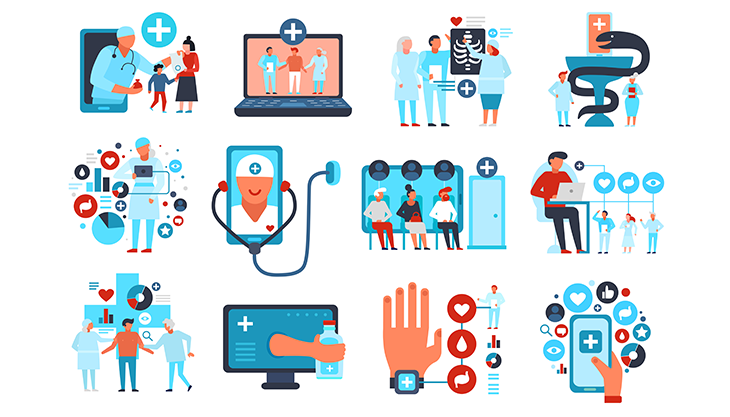What is Interoperability in Healthcare & How Will It Help My Practice?
Posted by Paolo Gabriel Demillo
Healthcare Technology EHR Practice Management
The internet and digital age have opened our eyes to the advantages and benefits of an interconnected world. As people and industries became more intertwined, the need for increased interoperability between software and systems grew, especially in sectors like healthcare.
Interoperability in healthcare is a critical concept that continues to revolutionize how medical practices function. With federal mandates to adopt electronic health records (EHRs) and the growing reliance on data-driven decision-making, achieving seamless interoperability between various systems and platforms has become paramount in healthcare information technology (HIT).
Understanding Interoperability in Healthcare

The term interoperability can be interpreted in many different ways depending on your viewing lens. So what does interoperability mean in healthcare?
Healthcare interoperability refers to the ability of different health information systems and technologies to receive, share, interpret, and use data cohesively—in other words, health information exchange. It enables seamless patient information and clinical data flow across other healthcare entities, including hospitals, clinics, laboratories, pharmacies, and even patient-facing applications.
Read More: What is HIE and Why is it Safer & Smarter Than Faxing?
The ultimate goal is to ensure that healthcare professionals have access to complete and accurate patient information when making critical decisions about diagnosis, treatment, and care.
The 4 Levels of Interoperability in Healthcare

The Healthcare Information and Management Systems Society (HIMSS) classifies interoperability in healthcare into four categories:
1. Fundamental Interoperability
Fundamental interoperability forms the basic foundation for data exchange. It focuses on the ability of systems to share and receive data, regardless of the structure or meaning behind that data. At this level, systems can transfer data but cannot interpret it.
2. Structure Interoperability
Structural interoperability focuses on the organization and formatting of exchanged data. It defines data exchange structures and syntax, ensuring that systems can understand and interpret the data received.
This level addresses data format, models, and encoding standards, such as the ICD-10 and ICD-11, and E&M coding systems. Structural interoperability allows for seamless transmission and interpretation of data between different systems, laying the groundwork for effective data utilization.
Read More: 2023 E&M Coding Changes: Should You Be Excited or Wary?
3. Semantic Interoperability
This level of interoperability is the highest rung on the ladder. It ensures that systems can understand and interpret the data in a standardized and consistent manner.
Semantic interoperability uses common terminologies, coding systems, and clinical standards to interpret clinical data accurately. This level of interoperability facilitates meaningful clinical decision-making so healthcare providers can confidently exchange and understand the clinical significance of the shared data.
4. Organizational Interoperability
Aligning healthcare organizations’ varying policies and workflows is the primary objective of organizational interoperability. It aims to facilitate the efficient exchange of patient information across various healthcare settings, enhancing coordination and continuity.
Organizational interoperability promotes the establishment of data-sharing agreements, governance structures, and data privacy protocols to ensure secure and compliant data exchange between entities.
How Interoperability Transforms Your Practice

Speed and convenience aren’t the only benefits interoperability brings. Its positive impact cuts across the different areas of practice operations. Here are four ways interoperability in healthcare transforms how you run your practice:
Enhanced Coordination & Continuity of Care
Interoperability is pivotal in promoting improved care coordination and continuity of care. Take a dedicated care team communication platform, for example. By enabling secure patient data exchange, you and your team can comprehensively view a patient’s medical history, including diagnoses, treatments, allergies, and medication regimens in real time.
Streamlined Workflow & Improved Efficiency
One of the key advantages of interoperability in healthcare is its ability to streamline workflows and enhance operational efficiency within your medical practice. By eliminating the need for manual data entry or repetitive administrative tasks, healthcare professionals can devote more time to direct patient care.
Interoperability enables seamless data transfer between systems, automates processes such as referrals and lab orders, and facilitates real-time collaboration among care teams. This increased efficiency improves patient care, reduces administrative costs, and enhances overall productivity.
Data-Driven Insights & Decision-Making
Interoperability empowers medical practices with a wealth of data you can harness to derive meaningful insights and support evidence-based decision-making. Integrated health information systems can leverage data analytics and machine learning algorithms to identify trends, patterns, and potential risks.
Read More: Healthcare Data Analytics: 4 Healthcare KPIs to Track in 2023
Improved Patient Engagement & Empowerment
Interoperability also plays a crucial role in improving patient engagement and empowerment. Patients can actively participate in their healthcare journey with advanced tools like a patient app or care portal.
Read More: Everything You Need to Know About IMS Patient App & Care Portal
They can view their test results, medication history, and treatment plans, fostering better communication with healthcare providers. By empowering patients with information, interoperability encourages shared decision-making and improves patient satisfaction.
Embrace Interoperability With Fully-Integrated Software

Interoperability in healthcare is a game-changer, redefining how medical practices operate and deliver care. Through the seamless exchange and utilization of health data, interoperability enhances coordination, efficiency, and data-driven decision-making.
Now that you’ve answered what interoperability in healthcare is, it’s time to embrace it in your practice fully. Having a fully-integrated EHR platform should be the first step of this process.
Meditab’s Intelligent Medical Software (IMS) is an all-in-one EHR, practice management, and medical billing solution that can support every area of your practice. With innovative features, an intuitive interface, and advanced mobile capabilities, IMS supports your practice from clinical to administrative, billing, patient engagement, and marketing needs.
Investing in interoperable systems and solutions is key to unlocking the full potential of digital healthcare and improving patient outcomes.
Share this post: on Twitter on Facebook on Google+


